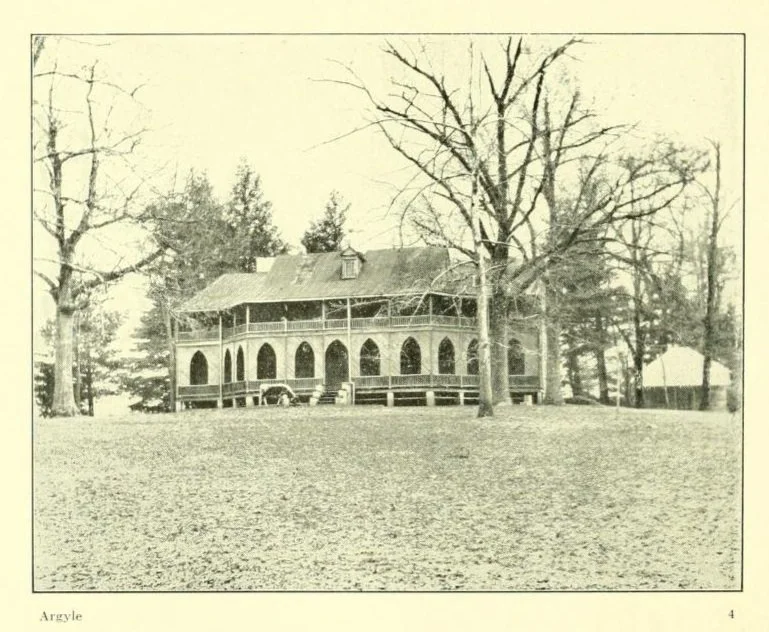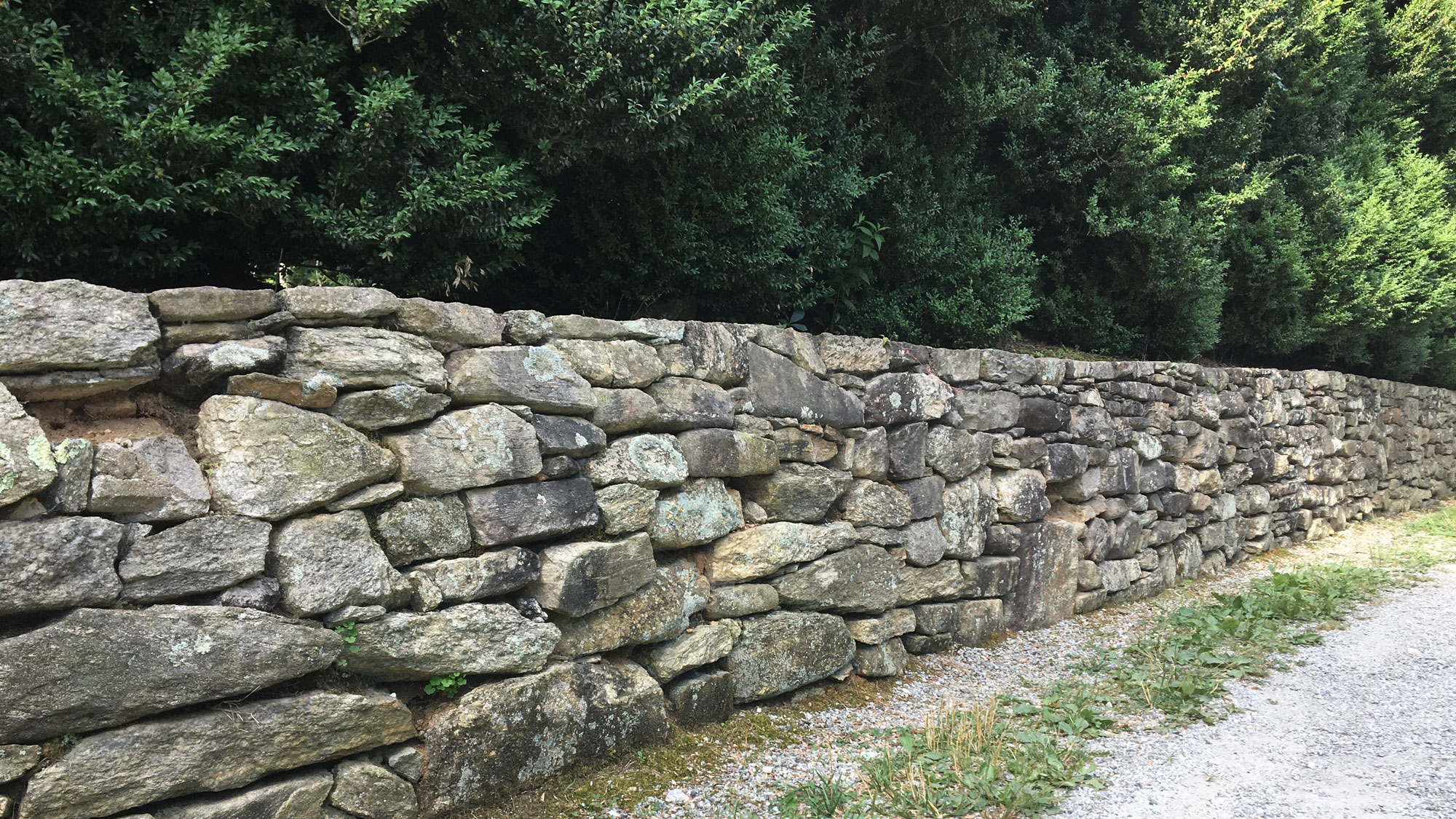A Sketch of the Past
/Introduction
One of the earliest published accounts of Flat Rock’s history was written in 1908 by Alicia Middleton Ripley Trenholm (1855–1926). Her book, A Sketch of the Past, offers a rare glimpse into the early days of this historic mountain village. While her prose may seem quaint to modern readers, the book brims with fascinating observations about Flat Rock's early settlers, homes, customs, and seasonal rhythms.
The original publication is now available online at Archive.org, accompanied by impressive images of some of Flat Rock’s earliest residences - some of which are still standing, and others lost to time.
The Lodge
Alicia wrote this book from her family’s summer residence at Mountain Lodge, one of Flat Rock’s earliest grand homes. Originally built by Charles and Susan Baring in 1845, the estate shifted hands following Susan’s death. Charles inherited the North Carolina property but, facing financial difficulties, eventually sold Mountain Lodge in 1853 to Edward L. Trenholm (1814–1883), a member of a prominent Charleston family. The Trenholms summered there until 1911, when they sold the home to George and Lucy Baldwin of Savannah.
Born on the last day of 1855, Alicia Ripley was the daughter of Confederate Brigadier General Roswell Sabine Ripley (1823–1887), who served in the Army of Northern Virginia and later wrote about his wartime experiences. At age 18, Alicia married Savage Deas Trenholm (1844–1895), son of Edward Trenholm. She is buried in the churchyard at St. John in the Wilderness.
The Trenholms were a distinguished Charleston family with deep Civil War connections. Her husband’s uncle, George Trenholm (1807–1876), was the Secretary of the Treasury for the Confederate States from July 1864 until the war’s end. He succeeded Christopher G. Memminger, who also owned a home in Flat Rock, Rock Hill, later renamed Connemara, and famously owned by Carl and Lilian Sandburg.
Alicia’s account describes Flat Rock during its first century—a small settlement shaped by Charleston families who sought refuge from the city’s summer heat and disease. Written in a friendly, conversational tone, the book captures a community’s pre-war elegance, wartime disruption, and a gradual post-war revival fueled in part by the arrival of the railroad.
What follows are short excerpts from her book.
--
Excerpts from A Sketch of the Past
ARgyle
Alicia opens her book by explaining her motivation: to introduce readers to Flat Rock, a place far less known than its more famous neighbor, Asheville.
“The development of Biltmore, has brought Western North Carolina prominently before the public… Comparatively few persons, however, know much about the interesting old settlement of Flat Rock… Indeed, there are many who would not appreciate the quiet, easy-going life, where some of the most cultured families of the South, spend the hot months of summer.”
She recounts how Charleston families first discovered and fell in love with the mountain plateau that would become Flat Rock.
“About ninety years ago, a few friends from Charleston, S.C., took the trip here to look for a suitable location for a summer resort… The scenery being beautiful… the graceful outlines of Pinnacle and smaller foot-hills charmed the sight, with their ever-shifting lights and shadows.”
“Not so very long ago, the roads in and around Flat Rock, were all densely wooded and shady… in Spring the wild violets fairly carpet the pathways, while festoons of the wild-rose hang from their bushes in sprays of delicate beauty.”
“For the variety and great profusion of wild flowers, this section of North Carolina ranks next to Japan; that is, where Nature has not been marred by the cutting of trees and ploughing up of civilization!”
Rock Hill (Connemara)
Alicia describes the rugged journey Charleston families endured to reach Flat Rock in the 19th century.
“Going to the Mountains” meant hard travelling… One can easily picture to themselves the lumbering, clumsy stage-coach… creaking and groaning… as the poor, tired horses… crept slowly up the steep grades.”
“The regular residents… drove up in their own carriages, and were usually followed by a train of wagons, bearing luggage, groceries, and the servants, quite a retinue to each family.”
She recalls the lavish social life that defined Flat Rock summers in its golden era prior to the Civil War.
“During the most prosperous period… prior to the Civil war, the social life must have been, truly, most delightful… costume balls, dinner parties, and various amusements.”
“On bright afternoons the Little River Road was thronged with carriages and riders—making a gay scene, and affording a pleasant opportunity of meeting one’s friends.”
Despite its remote location in the mountains of western North Carolina, Flat Rock was not spared the Civil War’s disruptions, and harbored a burgeoning cottage industry of homemade spirits.
“This secluded spot was in a constant state of turmoil… the inaccessibility of the mountains made them a safe hiding place for the deserters… ‘bushwhackers’ caused a great amount of anxiety and trouble.”
“Many a drink of ‘Moonshine’ has been quaffed in the dim retreats of the illicit distilleries… ‘Mountain Dew,’ ‘Moonshine,’ and ‘Quick Step,’ were fondly familiar names to the denizens of these hills!”
Cora Urquhart
In the book, Alicia makes a passing reference to one of Flat Rock’s earliest brushes with celebrity.
“Maybe it would interest some persons to hear that Cora Urquehardt(sic)—Mrs. James Brown Potter—used to spend her summers here, when quite a child…”
Cora Urquhart Potter (1857–1936) was a prominent American socialite turned stage actress who captivated audiences on both sides of the Atlantic during the late 19th and early 20th centuries. Born in New Orleans, she spent childhood summers in Flat Rock, where her father briefly owned the former estate of the Count de Choiseul.
Known for her beauty and poise, Cora became a leading figure in Gilded Age society before scandalizing polite circles by pursuing a career on the stage—an unusual and controversial choice for a woman of her social standing. Though her acting career faded in later years, her bold transition from society hostess to professional actress left a lasting impression on the era’s cultural landscape.
Alicia concludes her book with a hope that her recollections will preserve some part of Flat Rock’s unique story.
“To do justice to the ideal life, led here in days gone by, would really be impossible. If the words I have written… can convey even faintly… that life, I shall indeed feel gratified.”
Site of the Old inn on the Buncombe Turnpike (Greenville Highway)
Thanks to Alicia Middleton Ripley Trenholm, we have a precious, firsthand glimpse into Flat Rock’s 19th-century past—a world of carriages, wildflower-lined roads, moonlit balls, and the quiet, restorative summers that drew Charleston’s elite to these mountains.
Her voice, though rooted in her time, preserves the texture of life in a community finding its identity amid beauty, hardship, and societal upheavals. A Sketch of the Past is more than a nostalgic memoir; it’s an invitation to reflect on what makes Flat Rock—then and now—a truly special place.
--
You can see and read Alicia Riply Trenholm’s entire account of early Flat Rock at https://archive.org/details/flatrocknorthcar00tren/mode/2up
Postscript
An imagined conversation with the author in the year 2025.
FR Together:
Mrs. Trenholm. Thank you for taking the time to speak with us today
Alicia
Thank you most kindly for your interest and courtesy. It warms me to know that the echoes of our time still reach willing ears. And please call me Alicia. I haven’t been married for 130 years now
FR Together:
Of course.
Alicia, what motivated you to write A Sketch of the Past?
Alicia:
Why, I suppose it was memory - memory and affection. There are moments, particularly in the quiet of mountain twilight, when the past presses in so near it seems almost a duty to capture it before it slips away altogether.
I found myself, in my later years, thinking often of the days when Flat Rock was young and full of light-hearted voices, when the carriage wheels stirred dust on the Little River Road, and every home held laughter and long summer afternoons.
So, I wrote. Not as a historian, but as one who simply remembered. I hoped that perhaps, in putting pen to paper, I might preserve something of that vanished world for those who never knew it.
FR Together:
Why is Flat Rock such a special place in your mind?
Alicia:
Oh, it is the air, the trees, the very curve of the hills! Flat Rock is not simply a place—it is a feeling. It is the relief of cool mountain mornings after Charleston’s oppressive heat, the scent of laurel in bloom, the songs of thrushes echoing in wooded hollows. It was a refuge, you see, but also a society—gracious and unhurried—where the heart could rest, and families could renew themselves.
We built more than houses here; we built friendships, traditions, a kind of sanctuary. To me, Flat Rock has always felt like a page set apart from the wider world. A place where life could be lived more gently, with a touch of poetry.
FR Together:
What would you say if I told you that we are still reading and enjoying your book in the year 2025?
Alicia:
Why, I scarcely know what to say! How extraordinary—and humbling.
You must know, I never imagined such a thing. My little book was written merely for those who shared in the remembrances—neighbors, descendants, perhaps a few curious souls. That it should travel so far beyond its time astonishes me. And yet, I am deeply gratified.
If my recollections have helped keep the spirit of Flat Rock alive, if they have called forth a smile or stirred a memory in someone all these years hence, then I am content beyond measure. How delightful to know the past still has a voice.
FR Together:
Thank you for providing us with a glimpse into the storied past of our village.
Alicia:
My pleasure. Time moves ever onward, as it must, but I do believe there is value in looking back now and then—to remember not only what was, but who we were.

















